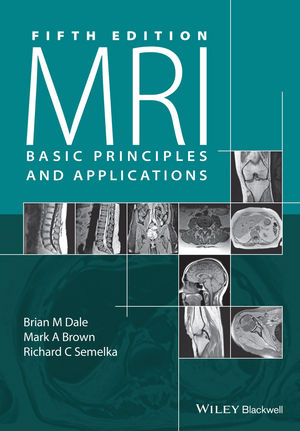
MRI
John Wiley & Sons Inc (Verlag)
978-1-119-01305-1 (ISBN)
- Accessible introductory guide from renowned teachers in the field
- Provides a concise yet thorough introduction for MRI focusing on fundamental physics, pulse sequences, and clinical applications without presenting advanced math
- Takes a practical approach, including up-to-date protocols, and supports technical concepts with thorough explanations and illustrations
- Highlights sections that are directly relevant to radiology board exams
- Presents new information on the latest scan techniques and applications including 3 Tesla whole body scanners, safety issues, and the nephrotoxic effects of gadolinium-based contrast media
Brian M. Dale, Ph.D. MBA is Zone Research Manager, MR R&D Collaborations, Siemens Medical Solutions, Inc. Brian is a younger colleague at Siemens of the previous co-author, Dr Mark Brown. Brian has a PhD in biomedical engineering from Case Western Reserve University in Cleveland, OH. His interests are in sequence programming and optimal design.
Mark A. Brown, Ph.D. is Senior Technical Instructor at Siemens Medical Solutions Training and Development Center. He received his Ph.D. in Physical Chemistry from Duke University, in Durham, NC. His research interests include relaxation and exchange phenomena and in vivo nuclear magnetic resonance spectroscopy and imaging.
Richard Semelka, MD, is Director of Magnetic Resonance Services, Professor, and Vice Chairman of Radiology at the University of North Carolina-Chapel Hill Medical School. He received his medical degree and residency training in radiology in his native Canada at the University of Manitoba, and completed a clinical research fellowship in MRI of the body at the University of California at San Francisco. Dr. Semelka has authored over 300 peer-reviewed articles, 12 textbooks including the Wiley Abdominal-Pelvic MRI and Current Clinical Imaging series and is an internationally acclaimed authority in the field.
Preface, ix ABR study guide topics, xi 1 Production of net magnetization 1 1.1 Magnetic fields 1 1.2 Nuclear spin 2 1.3 Nuclear magnetic moments 4 1.4 Larmor precession 4 1.5 Net magnetization 6 1.6 Susceptibility and magnetic materials 8 2 Concepts of magnetic resonance 10 2.1 Radiofrequency excitation 10 2.2 Radiofrequency signal detection 12 2.3 Chemical shift 14 3 Relaxation 17 3.1 T1 relaxation and saturation 17 3.2 T2 relaxation, T2* relaxation, and spin echoes 21 4 Principles of magnetic resonance imaging 1 26 4.1 Gradient fields 26 4.2 Slice selection 28 4.3 Readout or frequency encoding 30 4.4 Phase encoding 33 4.5 Sequence looping 35 5 Principles of magnetic resonance imaging 2 39 5.1 Frequency selective excitation 39 5.2 Composite pulses 44 5.3 Raw data and image data matrices 46 5.4 Signal-to-noise ratio and tradeoffs 47 5.5 Raw data and k-space 48 5.6 Reduced k-space techniques 51 5.7 Reordered k-space filling techniques 54 5.8 Other k-space filling techniques 56 5.9 Phased-array coils 58 5.10 Parallel acquisition methods 60 6 Pulse sequences 65 6.1 Spin echo sequences 67 6.2 Gradient echo sequences 70 6.3 Echo planar imaging sequences 75 6.4 Magnetization-prepared sequences 77 7 Measurement parameters and image contrast 86 7.1 Intrinsic parameters 87 7.2 Extrinsic parameters 89 7.3 Parameter tradeoffs 91 8 Signal suppression techniques 94 8.1 Spatial presaturation 94 8.2 Magnetization transfer suppression 96 8.3 Frequency-selective saturation 99 8.4 Nonsaturation methods 101 9 Artifacts 103 9.1 Motion artifacts 103 9.2 Sequence/Protocol-related artifacts 105 9.3 External artifacts 119 10 Motion artifact reduction techniques 126 10.1 Acquisition parameter modification 126 10.2 Triggering/Gating 127 10.3 Flow compensation 132 10.4 Radial-based motion compensation 134 11 Magnetic resonance angiography 135 11.1 Time-of-flight MRA 137 11.2 Phase contrast MRA 141 11.3 Maximum intensity projection 144 12 Advanced imaging applications 147 12.1 Diffusion 147 12.2 Perfusion 153 12.3 Functional brain imaging 156 12.4 Ultra-high field imaging 158 12.5 Noble gas imaging 159 13 Magnetic resonance spectroscopy 162 13.1 Additional concepts 162 13.2 Localization techniques 167 13.3 Spectral analysis and postprocessing 169 13.4 Ultra-high field spectroscopy 173 14 Instrumentation 177 14.1 Computer systems 177 14.2 Magnet system 180 14.3 Gradient system 182 14.4 Radiofrequency system 184 14.5 Data acquisition system 186 14.6 Summary of system components 187 15 Contrast agents 189 15.1 Intravenous agents 190 15.2 Oral agents 195 16 Safety 196 16.1 Base magnetic field 197 16.2 Cryogens 197 16.3 Gradients 198 16.4 RF power deposition 198 16.5 Contrast media 199 17 Clinical applications 200 17.1 General principles of clinical MR imaging 200 17.2 Examination design considerations 202 17.3 Protocol considerations for anatomical regions 203 17.4 Recommendations for specific sequences and clinical situations 218 References and suggested readings 222 Index 225
| Erscheint lt. Verlag | 12.10.2015 |
|---|---|
| Zusatzinfo | illustrations |
| Verlagsort | New York |
| Sprache | englisch |
| Maße | 171 x 242 mm |
| Gewicht | 484 g |
| Einbandart | kartoniert |
| Themenwelt | Medizinische Fachgebiete ► Radiologie / Bildgebende Verfahren ► Kernspintomographie (MRT) |
| Naturwissenschaften ► Physik / Astronomie | |
| Technik | |
| Schlagworte | MRI |
| ISBN-10 | 1-119-01305-4 / 1119013054 |
| ISBN-13 | 978-1-119-01305-1 / 9781119013051 |
| Zustand | Neuware |
| Informationen gemäß Produktsicherheitsverordnung (GPSR) | |
| Haben Sie eine Frage zum Produkt? |
aus dem Bereich


